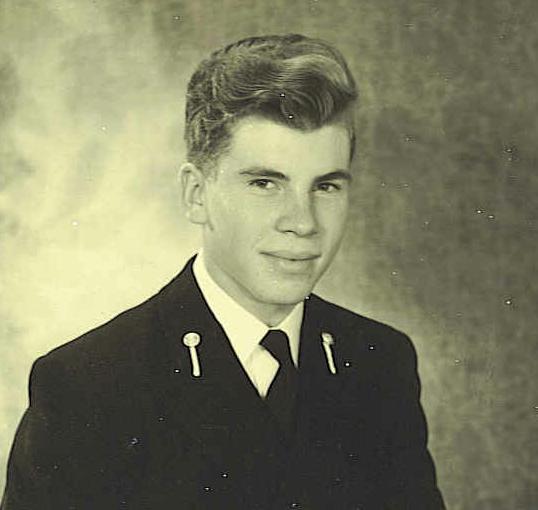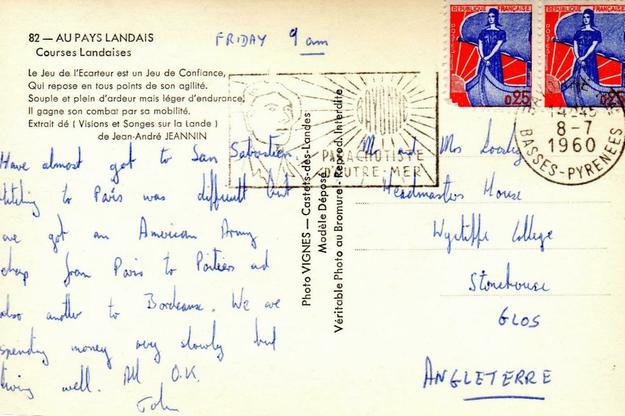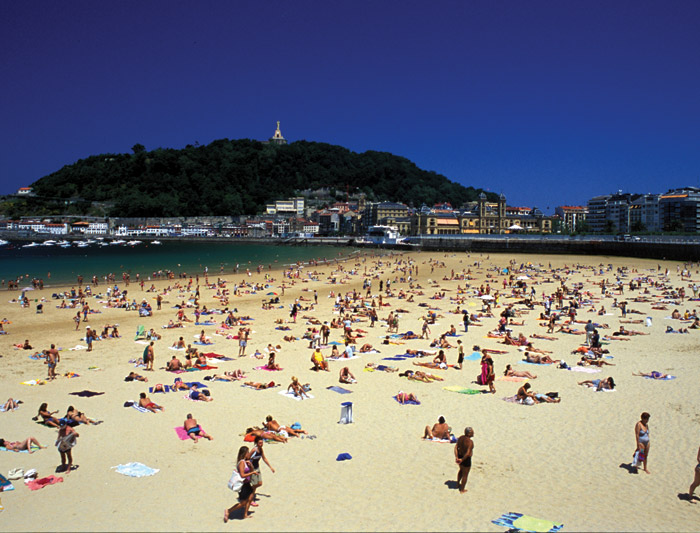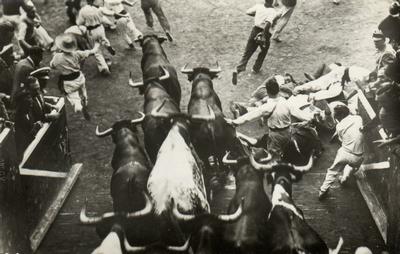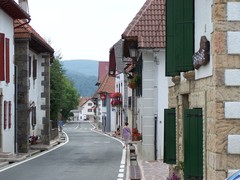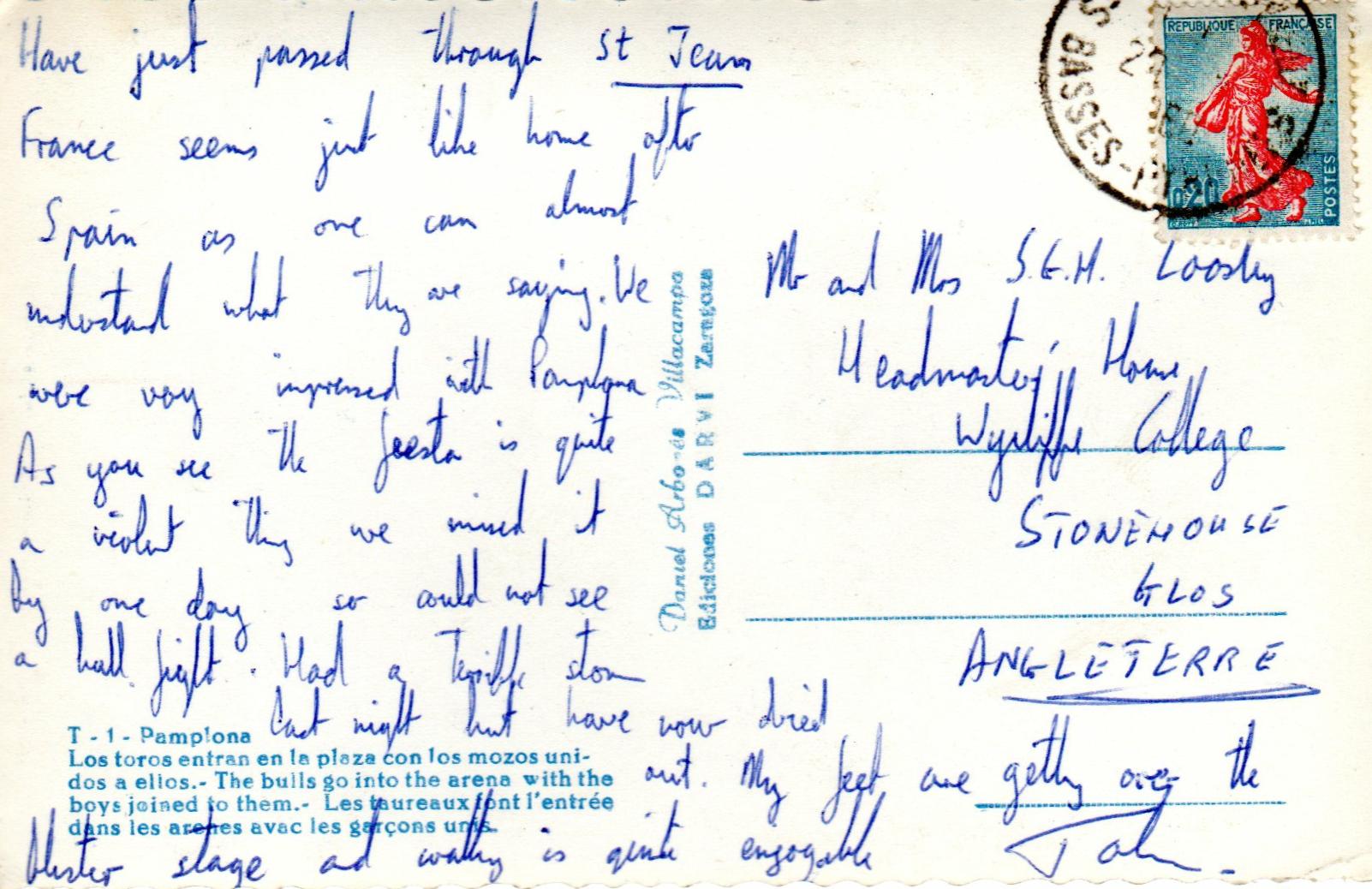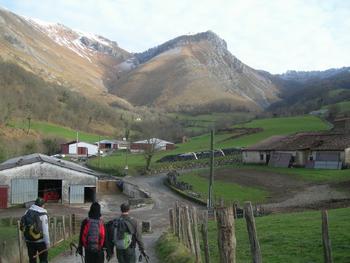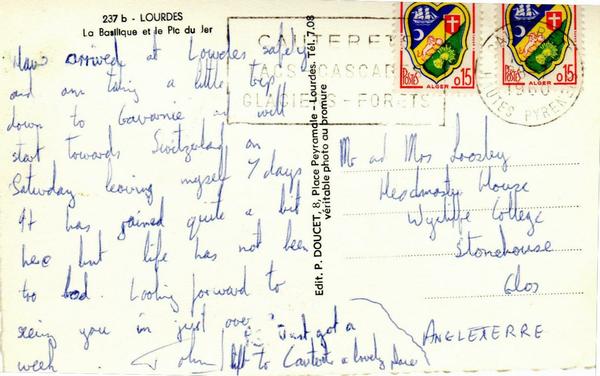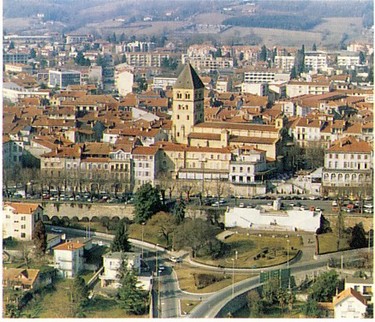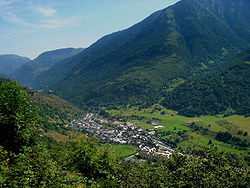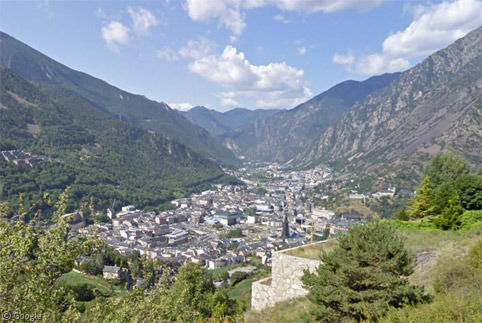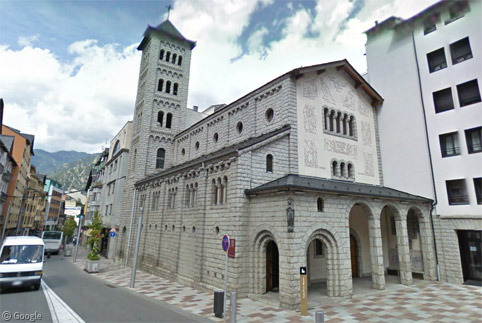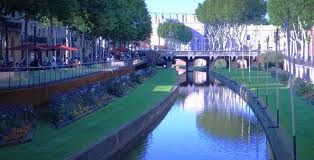|
of Midshipman A. C. Copple, R.N. IntroductionWhen a friend mentioned that the Pyrenees made ideal walking country, it occurred to me that to walk and climb from one end to the other would not only be very enjoyable, but also most suitable for my summer expedition. I became keen. Without worrying about details, I acquainted myself with a few relevant particulars. My walk appeared to be approximately 250 miles, direct, and so five miles a day would occupy two months.
PlanningThe best maps of the area available are the French 'Michelin' road maps 85 and 86. These unfortunately have no contours, and I was not very happy about them, but I had no other choice. Their scale is: 1 cm.= 2 Km. I ordered them from the Youth Hostels Association. To decide on a route in this mountainous country was tricky. I soon realised that my plan could at best be only a guide to my general direction, and would have to be altered in parts when I began walking. I did not know if trekking across country was feasible. However, I resolved to choose positions for each camping site, so as to simplify the task of working out how long each part of the trip would take. First, however, I chose my route on the map; a route which passed through as many places of interest as possible. In order that this report should not become too lengthy, I have tabulated a large amount of factual information in appendices. A glance at the map attached to Appendix (C) shows that my final route was by no means straight. In fact the distance was about 750 kilometres, or 465 miles. I placed camps at intervals of 10-20 kilometres, usually on streams or rivers. I included a certain amount of cross-country walking, but we were to find this for the most part impossible. I imagined too, that we would be able to undertake a number of excursions up mountains, but this we only managed on rare occasions. As a novice, I found it difficult to decide what to take with me on a two month's trip abroad. A friend, who had recently walked in Corsica, advised me, and we made a list of articles. Later, he was good enough to accompany me on a shopping trip to London, when I bought a large number of things. Since I began with no equipment, (except footwear - my father's old army boots) the cost finally ran to £15 - 20. This includes a rucksack, a Primus stove, and a very efficient windjammer, which, throughout the trip, kept me warm in cold weather, and cool when it was hot. A full list of articles taken appears in Appendix (B), with a guide as to their usefulness. John's was a small ridge tent, with ample room for two. He also had an entrenching tool. After having dealt with the obvious things, my problem boiled down to a) not knowing the availability of commodities in the Pyrenees, and b) deciding, in the case of foodstuffs, if the sizes and weights of things were compatible with the number of meals they would serve. For example, a tin of baked beans, both heavy and bulky, was an unwise purchase in England, (though unobtainable on the Continent,) since it would satisfy us for one meal only. But 'Oxo' cubes were the opposite in every respect, and thus an obvious choice. The foodstuffs that we eventually carried out from this country are also given in Appendix (B). The JourneyThe ApproachJohn and I passed through the customs at Calais, at 3.00 pm, on Sunday 3rd July. Our rucksacks seemed very heavy and conspicuous on our backs. Calais was enjoying a carnival, and it took us some time to get out on the main Paris road. Neither of us had ever before hitch-hiked in earnest, and thought we were prepared for the worst, but we were very disheartened that evening, when by seven o'clock we had received no lift, were very tired, and aching in several places. But now we had another new experience; that of camping out. All went well on our first night under canvas, except that the amount of sleep we got wes negligable, but we were optimistic enough to expect it to become better as we became more used to it. The porridge we cooked before setting out the next morning was a washout. We were elated when a nice looking sedan stopped for us about half-an-hour after we had begun hitching that morning, and after that our luck changed. (Our philosophy as regards this dubious sport of hitching also changed. We became quite used to waiting several hours, and never lost the hope that the next car might stop. We reached Paris early on Tuesday morning, in foul weather, and worked our way beneath it on the Metro as far South as possible. Then we worked our way to the Route National 10, which runs South from Paris to Bayonne, and soon were lucky enough to receive a lift from an American army Lieutenant, some 260 kilometres to Poitiers. We stayed the night in a Youth Hostel. I had originally intended to spend all our nights in youth hostels on this first part of the trip. This had been impossible, and it had been lucky for us that I had brought some paraffin for the Primus. By now, however, our supply was dwindling, but when I asked in Poitiers for "du paraffine", I was told that it was unobtainable. This was worrying, but there was nothing we could do about it, and we decided to try again later.
The Walk Part 1I am not now going to relate a day to day report of our journey. That is given in the Appendix. What I propose to do is to state the several aims of the trip, and show how we were able to fullfil those aims. I shall also mention, without too many dates or names, any points of interest about the country we passed through and the people we met. The task I had set myself was to walk from San Sebastian to Perpignan, and to live as cheaply as possible on the way. I was not over concerned with how long this would take; indeed, to follow the route that I had planned it was not even of prime importance, and, as we shall see, I was forced to alter it on many occasions. In the middle of the trip I had planned a short variation, namely a train journey from Lourdes to Gavarnie and back. After having written my original plan, one change already had cropped up. The cause of this was my decision to meet my brother in St. Gaudens instead of Luchon. Philip had been to St. Gaudens before, and I decided that there would be less risk of missing one another if we could both make ourselves known, on arrival there, to the people with whom he had before stayed. A glance at the map in Appendix (C) shows how my revised route differs from that of my original plan. In my original plan, I had divided the journey into six stages. In this final report, I propose to think of it as three, since that is how it seemed to me as I was walking. Firstly, my journey with John, from San Sebastian to Lourdes. Secondly, my fortnight alone, during which I made the week's journey from Lourdes to St. Gaudens, and then rested a week there. And thirdly, the trip from St.Gaudens to Perpignan, I shall attempt to contrast both the country we saw, and the people we talked to in each stage, and also to show the changes, both physical and mental, which came about in me and my companions. The first week was a great testing period for both of us. There is a very fine road connecting San Sebastian and Pamplona, but we chose to follow a route which lead us away from the traffic, and which wound remarkably slowly through the mountains which the more modern route bypassed. It was the very windiness of this road which was responsible for our first problems. In planning, I had reckoned that a mere 12 kilometres or so, that is 6 centimetres on the man, would prove an easy walk, and even allow for the odd afternoon's excursion up a nearby peak, once we had encamped. But with a road which was infested with hairpin bends, and seemed to go back on itself for a good proportion of the time, much of which was not shown on the map, we two inexperienced, unfit hikers found ourselves with 17 or 18 kilometees to walk each day in very hot weather, and very seldom along the level. I well remember the third day of our walk when we stopped every half kilometre for a rest, and had to force ourselves not to give in, camp on the spot and go straight to bed. The cross country walking I envisaged during this first week was completely out of the question; the road we were following, as the map shows, was cut out of the mountainside, and to leave it was impossible. The alternative was the route I have marked, which met the main road to Pamplona at Lecumberri. But it was not all plain sailing thereafter; we began to wonder if those mountain curves hadn't each one been blessings in disguise. The kilometres seemed to pass more slowly than ever. The car horns forced one into the rubble at the side of the road, and made one lose the rhythm of walking. To pass a kilometre stone, and to be able to see the next one a kilometre ahead seemed many times worse than the feeling that it might always be around the next corner.
There is no doubt that that first week was not an experience I should like to repeat; and yet, as I look back, and compare it with other passages of difficult country, I realise that it was not exceptionally hard. What made it seem so were our lack of fitness (especially mine), the blisters which troubled us most of the way (especially mine), and the hot sun which beat down on our heads unceasingly all day (especially mine). Also, we were mentally unaccustomed to walking for several hours at a stretch. And even when we weren't particularly tired, we were always prepared to take a rest every three hours, as we had done since the start. In the mountains we walked three kilometres in three quarters of an hour, then tested till the hour was up. The people we met during that first week were most charming. In one village, a shopkeeper who had been very generous in serving us with wine, then phoned a woman at the village, who could speak several languages, especially to talk to us. As it happened, this was a good thing for us, as neither, of us knew any Spanish, and were using the dictionary for every word we said. The village shops were able to supply us with everything we required for our cooking, which at that stage was very simple, and we soon learnt how very cheap commodities are in Spain. The next few days was a period for gaining experience, Compared with the mountain road we had already come up against, it was not very strenuous, but we still had a very hot sun in the Spanish tradition to contend with. These next few days are memorable mainly as a period during which we lived on the very minimum of food. We could get no butter or fresh milk, and were lucky even to be able to buy bread. The milk situation was surprising, since cows were abundant, but I imagine it would only have been possible to buy milk at a certain time of the morning each day.
We now looked forward to a stretch of relatively flat country, but first I had my boots repaired by a village cobbler. The recent mountain walking had dislodged most of the hobnails, and I got him to put in some more, which he did very cheaply. On Friday 22nd July, we were the only "guests" at the Montory Youth Hostel, a delightful house, where we were able to give many of our clothes a much-needed wash in hot water. The system in hostels in that one may use as much butane as one requires; the all-in tariff of about two shillings and threepence covers the cost. We found sleeping in beds a wonderful experience, as we were still not used to the ground. We walked on through Arette and Lurbe, and then along the 17 kilometre stretch through the Bois de Bager. Half way along this village-less road, we had our only night sleeping in a barn. Rain was coming down in sheets, and we approached a fine looking farmhouse, found it deserted, and waited till either the rain stopped, or the owner returned. When he did, he was a little put out at finding us sitting in his store-room, but his wife persuaded him to allow us to spend the night in hie barn; it proved a most clean and comfortable one. Next day, we made a short walk to Arudy, in order that we might spend the afternoon on a hitch-hiking trip to Pau. I believe this is the largest and most modern town in the Pyrenees. Hitching each way was simple, without sacks, and the town was resplendend in the warmest sunshine we had had since leaving Spain. We were beginning now to complete our walking quite early each day, and partly because of this, and partly due to a lingering memory of home cooking, we began to experiment with bigger and better meals. In the towns we passed through regularly now, we could buy almost all we wanted. Dishes as tasty as shepherd's pie, mushroom and ham omelet, pancakes, and macaroni pudding became regular items on our menu. I regret it was a definitely English menu at this stage. We always ate porridge, with coffee or tea, for breakfast, bread and jam with fruit at midday, and our large evening meal at six. We were invariably ravenous when the time for food was near.
The French practice of camping under canvas at night, while on a touring holiday was amply demonstrated here; there were several official camping sites. We, however, stayed the night in the extremely good youth hostel there. Our return to Lourdes was easily accomplished the next morning. We set up camp, and in the afternoon, had a look at this rather disappointing town, a mass of souvenir shops. We were unfortunately not allowed to see the famous Grotto, as our clothes were unsuitable, I have a photograph of the cathedral, which is extremely beautiful, and perhaps makes up for the commercial bent which the town has assumed. John left to hitch to Switzerland early the next morning. The Walk Part 2 - On my ownMy greatest worry about walking alone had always been whether the load I would have to carry would be too great for comfort. I found that the weight of my rucksack was increased by about half, but though this made it extremely heavy to lift off the ground, once it was on my shoulders it did not trouble me very much, My brother was to meet me in St. Gaudens, about a fortnight after I left Lourdes. At our previous rate of walking, I knew I could get there in a week, and I decided, to do this, rather than walk half-distance each day, as I felt that to stay in St. Gaudens for several days would be of some benefit to me, I wrote my brother, and instructed him to send a letter to the house of the family with whom he had stayed, some three years before, and enclose a letter for me, which I would pick up when I arrived. Thus he could let me know the date and time of his arrival by train in St. Gaudens, and also perhaps give me some home news. I had expected that walking by myself would be a lonely business, and indeed, for the first day or two, I found I was talking to myself for company. When this wore off, however, I realised that to be alone had advantages. I could vary my pace to suit my mood, I could stop to remove stones from my boots without annoying a companion. The time when I did miss John was when setting up or packing up camp, and it was the reaction against this part of my routine which at this stage helped to make me gain more pleasure from the walking part. Although I did not follow my original route from Lourdes to Bagneres, I went up into the mountains again, after Bagneres, as planned. It was from a point about half way between Bagneres and the village of Banios, that I saw what must be one of the most spectacular views of the range of the northern Pyrenees, In front of me, over almost 180 degrees was the flat plain. From east to west, the range of mountains rose out of that plain almost in a straight line. It was a view I shall remember for a long time. By La Barthe, I had again left this northern range of the Pyrenees. I mention this again, because nowhere else was it so possible to say that we had "come out of the mountains." The division between mountain range and plain was so very well marked. The roads to St. Gaudens were now straight and flat, and I feel that it is significant that now I had begun to derive a certain amount of pleasure from walking in the more hilly country, I found them a little uninteresting. St. Gaudens itself was visible for some ten kilometres before I reached it, and when I entered it, very tired, after my longest walk alone, it seemed a more friendly town than others I had passed through. This was just a fortaste of the hospitality of Mme. Larrieu, my brother's acquaintance, who quickly made me feel very welcome, when I stumbled on her house, while making my way through the town,
I kept myself fit at St. Gaudens by taking long walks through the surrounding countryside in my boots. I also attempted a hitch-hiking visit to Toulouse, but. found it so difficult to get any further than a third of the way along the Toulouse road, that I changed ray destination to St. Girons. I stayed there overnight in the very large youth hostel, and returned to St. Gaudens the next day, feeling that the excursion had been well worth while. Philip was not on the train on Friday. Panic! A long distance phone call to England did not clarify the situation, but did confirm there had been no change in plan. For some time I was pretty worried. The only thing I could think of was to meet the train coming in the next day. Indeed, Philip arrived on Saturday. There had been a miscommunication somewhere.
The Walk Part 3 - Joined by PhilipWe decided that in order to give him a rest after his long train journey, that we should begin stage 3 early the next morning. He rather worried me with the news that he had a seat booked on the Barcelona Express on September 2nd. This meant we would be rather pushed for time, and I decided that to save a few days, we should take the train from St. Gaudens to Luchon, a journey that in fact carried us no further eastwards, We were therefore not really cheating. But even with this concession, we were going to be very much pushed. The journey to Luchon took us through some extremely picturesque country. We were not able to change our money in Luchon, it being Sunday. We left the town after lunch on the road to Spain. The first ten kilometres up to the Col du Portillon were extremely steep, and finding a very fine camping site by the Col, we decided to stop the night there - Philip's first night under canvas.
Next morning, it was all downhill to Bossost. We were able to make several short cuts; the last bypassed the police post at the road junction, but as the man only seemed to be looking at passports and then waving cars on without stamping them, we did not worry. What we did not know was that he told people to go actually into town, to have their books stamped by the police there. The yellow flag on the map marks the post that we thus missed. We continued along the road. At Viella, we changed a traveller's cheque, having been able to use French money, (and speak French) up till then. Philip was entering the blister stage now. He had been walking very well — much more comfortably than I when I had begun, and though he was to suffer rather more with the various foot troubles that a walker
is prone to, he did not allow this to jeopardise the successful completion of the rather longer walks we were soon to have to make. On the way to Salardu, the road was being resurfaced. The white gravel reflected the hot sun which had been with us since Bossost, and made walking, for a time, very unpleasant. We were also threatened now with being unable to obtain any paraffin until we reached Andorra. At Viella, we had been told that it was not possible to buy any in this part of Spain at the moment. I envisaged
It was important to us psychologically to make a good early start each morning. We were getting up at six, and leaving camp by a quarter to eight, but yet we found 25 kilometres too much to keep up every day, and, on Monday, the day we passed through Ax, we only managed about 15. Monday is memorable for a wonderful swim we had in the lake at Goulours. The water was incredibly warm, although the weather had been rather coo], apart from that day. Tuesday was another 28 kilometre day. It began with a short climb in thick cloud to the Port de Pailheres, and continued with a long descent to civilisation again in the valley below. On Wednesday we managed only 16 kilometres, owing to the fact that the long climb up to the Col du Jan came in the second half of ' the walk. If we had been able to make the Col du Jau that night, and perhaps have gone down a few kilometres the other side, we might have reached Perpignan by Friday evening. As we did not, I decided there that it would be better for Philip to take the train from Prades, which we would reach Perpignan on Friday morning. We had walked extremely well. The weather, on the whole, had been kind. And yet, just on the days when we had needed most of all cooling winds, with perhaps a spot of drizzle, the sun had come out, and made it more difficult for us. Philip had found the going more difficult than I, which was natural, when one considers how much longer I had been walking. The march the next day, Thursday, was 31 kilometres, our record, all the way to Prades, and it was during this walk that we saw our first evidence of this being the most important fruit-growing district in France. Throughout the Pyrenees, we had been able to pick apples off roadside trees, but here, not only were the apples the nicest I have ever tasted, but also there was an abundance of peach trees; the fruit was being picked as we walked through the district . It was beautifully ripe. There were also pears and grapes, We camped on the outskirts of Prades, and amongst other things, I bought some paraffin, the two litres from Rossost having lasted us till now.
The ReturnI began trying to hitch out of Perpignan the next morning. Since I was alone, I was expecting to have an easier journey than the outward one, but here again it seemed to take a long time to get started. I was struck by the way a large number of very likely looking cars ignored one, and then someone, who one would never expect to stop, really goes out of his way to help, In this case a woman came running back from a garage some distance up the road, where her car, with the rest of her family inside, had stopped for petrol. They took me to Narbonne. After two more lifts that day, I reached Nimes, where I camped for the night. Next morning I had a short lift, early, into Resmoulins, and then, just as I had given up hope, after having waited for about four hours, and was walking back into town to find out about buses to Avignon, a young Frenchman stopped for me, and delighted me with the news that he could take me right up to Paris, stopping a night on the way. The journey was great fun. He was an extremely nice man, and was most concerned for my comfort when we stopped for the night at Le Puy, after an exhilarating trip through the mountains from Valence. Le Puy is famous for its statue of the Virgin, high up above the town, on one of the incredible rocks, of which there are several examples in that part of the country. There is also, perched on a similar rock, a chapel, and at night, the two, floodlit, with the full moon between them, was an awe-inspiring sight. I spent the night encamped in an official camping site, while my benefactor went to a hotel. Next day we sped up to Paris, arriving at about nine o'clock along the new 'autoroute,' which we joined just North of Fontainbleau. It was pouring with rain, and travelling on this first rate highway, with its illuminated signs, was very exciting. We parted at one of the metro stations, and I went North to Port de la Chapelle, to spend the night at the Youth Hostel there. In three short lifts early the next morning, I got 50 kilometres outside Paris, and then an amazing coincidence occurred, A car stopped for me, driven by a Canadian, about 22 years old, who, to my delight, was in a great hurry to reach Calais for the one o'clock boat train. His voice seemed vaguely familiar, but I put this down to his being Canadian: John and I had met a party of three Canadians at the Cauterets Youth Hostel. Imagine my surprise, when it came out in conversation half-an-hour later, that he was actually one of them. I then remembered the car, which they had had with them. The other two had left him in Spain, It was a near thing, catching that boat train. We arrived some ten minutes before it left, and were greeted by some angry officials. But the passage was booked, and they found room for us. This however meant that we were first off the boat and through the customs at Dover. Getting used to left-hand traffic was easier than we had expected, and we were in London by six.
Date Distance walked (Km) Position of Camp
SPAIN
8 July 6 1 Km. before Astigarraga. *
9 17 2 Kms. after turning to Arano, by an unmarked small village.
10 11 2 Kms. after Goizueta.
11 15 At Leiza. Scrambled to the 'peak' of a nearby hill.
12 18 At Urriza.
13 16 I Km. after turning to Ar-^sa, Pamplona was visible
from a highspot 1/2 Km. after this camp.
14 10 Just outside the walls, to the North of Pamplona.
15 14 I Km. before Larrasoana, in an orchard.
16 15 Erro. Washed our clothes in the village wash-house.
17 14 I Km. before Burguete.
FRANCE
18 21 At Valcarlos. Our first thunderstorm. *
19 12 I Km. East of St. Jean Pied de Port. *
20 17 Near the Pic de Behorleguy.
21 18 At Alcay.
22 10 Montory Youth Hostel; had it to ourselves. Made elderberry jam.
23 17 At Issor. Procured a biscuit tin. for baking. No lid.
24 17 A barn, half way between Lurbe and Arudy.
25 10 I Km. after Arudy. Hitched to Pau and back.
26 16 Bruges. searched hard, found cobbler, who mended my boots (100fr)
27 17 St. Pe Youth Hostel.
28 10 Walked to Lourdes; hitched to Cauterets; Youth Host. Met Canadians.
29 - 'Official' camping site, Lourdes. *
30 7 2 Km. before Loucrup. Hitched to Lourdes for provisions.
31 11 'Official' camping site at Pouzac. Second thunderstorm.
1 August 12 At Banios.
2 13 Laborde. At long last got a lid for my biscuit tin oven.
3 11 La Barthe. *
4 8 St. Laurent Youth Hostel.
5 14 St. Gaudens. *
6 - 13 - St. Gaudens. Visited St. Girons; stayed in youth hostel.
14 10 Train to Luchon; walked to Col du Portillon.
SPAIN
15 14 By turning to Las Bordas.
16 13 At Gares. Had a good swim in the Garona.
17 9 4 Kms. past Salardu. Passport trouble.
18 16 3 Kms. below the 'Refuge'. Made some fudge.
19 20 La Guinguela, Lost, and found, my watch.
20 14 Llavorsi. Baked shortbread. Bought a watermelon.
21 13 I Km. before Sort.
22 14 Hard, hot, climbing to just past les Llagunes.
23 16 Crossed 2 cols. Camped near unknown village.
24 17 Uncomfortable walk to village 8 Kms. south of Seo.
25 8 'Official' camping site, with swimming pool, Seo.
ANDORRA
26 25 I Km. before Encamp. Passed through Andorra la Viel
27 28 Pas de la Case. Found wild raspberries; made jam *
FRANCE
28 24 2 Kms. past Merens.
29 15 By where Le Pere is marked; we found no sign of it.
30 28 By the turning to Escouloubre.
31 16 6 Kms. before col de Jau. Made a fire (!)
1 September 31 Prades. Record walk, and free fruit. *
2 27 Just passed Millas. A very hot day.
3 16 Perpignan. Mission accomplished.
TOTAL: 751 Km.
(*) Camping site NOT on a stream or river. This meant we had to be careful with the drinking water I collected each day from a
reputable source, but it was no real inconvenience.
ARTICLES TAKEN REMARKS
Rucksacks John's and mine large - Philips a small one.
Tent Let through a very fine spray when it was raining hard.
Entrenching tool Essential.
Ground sheet Served us extremely well.
Primus stove Caused trouble only once, when a nut on the plunger
came loose, luckily in St. Gaudens.
Methylated spirit Facilitates lighting the Primus, but not essential
Paraffin We took a small quantity to start us off.
Sleeping bags My waterproof one had a distinct advantage over
John's ordinary type
Billies: One round billie with frying pan lid - Worth their weight in gold
Two army surplus mess tins
Water carrier, (polythene) Perhaps our most useful single item; used every day.
Tin and bottle opener
Polythene water flask We used it for milk.
Tea cloth Unconventional camping equipment, but often useful.
Polythene bags 101 uses, including that of keeping bread fresh.
Sheath knife A phoney as far as we were concerned. We used it only
for sharpening tent pegs, and it blunted soon.
Maps We some times found details wrong; annoying.
Diary A page every night ...
Writing paper & envelopes All my envelopes stuck themselves up.
Ball-point pen
'Housewife' My supply of needles & thread was handy for both
blisters and darning
Sellotape Invaluable, from preventing condensed milk issuing from
half-empty tins, to emergency elastoplast.
Sunglasses I sat on them during the first week. No real loss.
String For clotheslines, and tying up Polythene bags.
Knife, fork & spoon set
One flat plate
Polythene mug
Small serrated knife For cutting bread, bought in Lourdes
Pot scourer Also bought in Lourdes
First aid set Included lint, elastoplast, burn dressing, Dysentry tablets,
and Acriflex, an antiseptic. Much used.
Sun-tan cream Efficient; we did not suffer from sunburn.
Toilet paper Ran out just before the end!
Matches
Khaki shorts
Long khaki trousers
Bathing trunks
Two shirts
Pyjamas
Towel
Toilet articles
Household soap Washing clothes in streams was not difficult as
the water was usually soft
Two pairs of socks Protection from Blisters (to a certain extent).
Six packet soups Good value.
Jar of Bovril.
Oxo cubes We only had stew a few times, but it was good.
Sugar Just to start us off.
Sweetened condensed milk Had some with us throughout.
Tea
Instant coffee
Cooking fat After one packet we used olice oil, much more convenient
Dextrosol tablets (glucose) Psychological succour with energy
Liver salts
The actual maps were submitted with the report, but these notes still hold some interest.
1. Hitch-hiking map.
The 'Shell' map of France shows the hitch-hiking route.
a) A change in colour (green - blue) denotes a different lift.
b) Where the route is in pencil, we used public transport.
c) Symbol 1 shows where we camped.
Symbol 2 shows where we stayed in a Youth Hostel.
2. Walking maps.
The 'Michelin' maps 85 and 86 show the walking routes.
a) The route as I originally planned it is denoted by a black line.
Camps are shown by black flags.
b) The actual route we took is given by a blue line, with camp flags in blue.
c) The number, by a camp, gives the number of nights since leaving San Sebastian.
d) Nights stayed in Youth Hostels are denoted by symbol 2
e) Hitch- hiking routes are shown in green.
The original typescript was scanned and uploaded on 10 March 2013. Only 53 years late. My sincere acknowledgements to John (Loosley) who unearthed the postcards sent to his parents, and permitted me to include the backs as well as the fronts. 50 Years on
|
